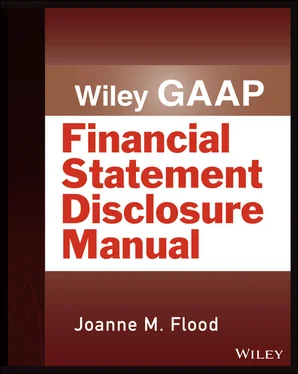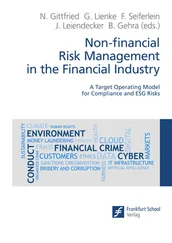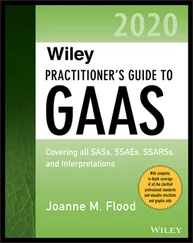To achieve this goal, the entity must:
Identify and describe significant accounting principles followed and methods of applying them that materially affect statements; disclosures should include principles and methods that involve:Selection from acceptable alternatives.Principles and methods peculiar to the entity's industry.Unusual or innovative applications of GAAP.(ASC 235‐10‐50‐1 and 3)
Among others, common accounting policies are:
1 Basis of consolidation
2 Depreciation methods
3 Amortization of intangibles
4 Inventory pricing
5 Recognition of revenue from contracts with customers
6 Recognition of revenue from leasing operations(ASC 235‐10‐50‐4)
Accounting policies disclosures should not duplicate details presented elsewhere. It may be appropriate to refer to related details presented elsewhere in the financial statements. (ASC 235‐10‐50‐5) While recognizing the need for flexibility, the Codification notes that it is preferable to disclose significant accounting policies in a separate summary preceding the notes to financial statements, or as the initial note, under the same or a similar title. (FASB ASC 235‐10‐50‐6)
DISCLOSURE EXAMPLES
Accounting Period
Example 7.1: Fiscal PeriodThe Company's fiscal year ends on the Sunday closest to January 31 of the following year, typically resulting in a 52‐week year, but occasionally giving rise to an additional week, resulting in a 53‐week year. Fiscal 20X8 was a 53‐week year. Fiscal 20X7 and fiscal 20X6 were each 52‐week years. Fiscal 20X8, 20X7, and 20X6 ended on February 3, 20X9, January 28, 20X8, and January 29, 20X7, respectively.
Example 7.2: Change in Fiscal Year‐EndIn January 20X2, the Board of Directors of the Company approved a change in the Company's fiscal year from that of a calendar year‐end beginning on January 1 and ending on December 31 of each year to a fiscal year beginning on July 1 of each year and ending on June 30 of the following calendar year. This change to the fiscal year reporting cycle began July 1, 20X2. As a result of the change, the Company had a six‐month transition period from January 1, 20X2 to June 30, 20X2 (the “transition period ended June 30, 20X18”). Accordingly, the Company is reporting its audited financial results as of and for the fiscal year ended June 30, 20X3, the transition period ended June 30, 20X2, and the calendar year ended December 31, 20X1, in this Annual Report.
Example 7.3: Receivables and Allowances for Doubtful Accounts and Composition of Other ReceivablesAccounts receivable are presented at net realizable value. The Company maintains allowances for doubtful accounts and for estimated losses. The Company reviews the accounts receivable on a periodic basis and makes general and specific allowances when there is doubt as to the collectability of individual receivable balances. In evaluating the collectability of individual receivable balances, the Company considers many factors, including the age of the balances, customers' historical payment history, their current credit‐worthiness, and current economic trends. Receivables are considered past due after 180 days. Accounts Receivable are written off against the allowances only after exhaustive collection efforts.
Other receivables represent mainly prepaid employee insurance and welfare benefits, which will be subsequently deducted from the employee payroll, and guarantee deposits on behalf of shipowners as well as office lease deposits.
Example 7.4: Accounts Receivable, Including Amounts of Allowance AccountsAccounts receivable are recorded, net of allowance for doubtful accounts and sales returns. Management reviews the composition of accounts receivable and analyzes historical bad debts, customer concentration, customer credit worthiness, current economic trends, and changes in customer payment patterns to determine if the allowance for doubtful accounts is adequate. An estimate for doubtful accounts is made when collection of the full amount is no longer probable. Delinquent account balances are written off after management has determined that the likelihood of collection is not probable and known bad debts are written off against the allowance for doubtful accounts when identified. As of August 31, 20X2 and 20X1, the allowance for uncollectible accounts receivable was $829,054, and $1,015,282, respectively.
Example 7.5: Marketing and Advertising ExpensesMarketing and advertising expenditures are expensed in the annual period in which the expenditure is incurred.
Example 7.6: Advertising Expenses and Promotional CostsAdvertising and promotional costs are generally expensed at first showing. Advertising and promotional costs and cooperative advertising allowances were as follows:
|
20X3 |
20X2 |
20X1 |
| (In millions) |
| Gross advertising and promotional costs |
$1,358 |
$1,397 |
$1,547 |
| Cooperative advertising allowances |
196 |
289 |
394 |
| Advertising and promotional costs, net of cooperative advertising allowances |
$1,162 |
$1,108 |
$1,153 |
| Net sales |
$24,971 |
$24,939 |
$25,908 |
| Advertising and promotional costs, net of cooperative advertising allowances, as a percent to net sales |
4.7% |
4.4% |
4.5% |
Example 7.7: Cash EquivalentsFor the purpose of the statement of cash flows, cash equivalents include time deposits, certificate of deposits, and all highly liquid debt instruments with original maturities of three months or less.
Example 7.8: Cash Equivalents—No Cash EquivalentsCash and cash equivalents include cash on hand and on deposit at banking institutions as well as all highly liquid short‐term investments with original maturities of 90 days or less. The Company did not have cash equivalents as of December 31, 20X2 and 20X1.
Example 7.9: Comprehensive Income (Loss)The Company reports comprehensive income (loss) in accordance with the FASB issued authoritative guidance which establishes standards for reporting comprehensive income (loss) and its component in financial statements. Comprehensive income (loss), as defined, includes all changes in equity during a period from nonowner sources.
Example 7.10: Concentration of RiskFinancial instruments that potentially subject the Company to concentrations of credit risk consist principally of cash. The Company places its cash with high quality banking institutions. The Company had cash balances in excess of the Federal Deposit Insurance Corporation limit as of December 31, 20X1.
Example 7.11: Concentration of RiskAccounts receivable are primarily from wholesale accounts, for landlord lease inducements, and from license and supply arrangements. The Company does not require collateral to support the accounts receivable; however, in certain circumstances, the Company may require parties to provide payment for goods prior to delivery of the goods. The accounts receivable are net of an allowance for doubtful accounts, which is established based on management's assessment of the credit risk of the underlying accounts.
Cash and cash equivalents are held with high‐quality financial institutions. The amount of cash and cash equivalents held with certain financial institutions exceeds government‐insured limits. The Company is also exposed to credit‐related losses in the event of nonperformance by the counterparties to the forward currency contracts. The credit risk amount is the Company's unrealized gains on its derivative instruments, based on foreign currency rates at the time of nonperformance. The Company has not experienced any losses related to these items, and it believes credit risk to be minimal. The Company seeks to minimize its credit risk by entering into transactions with credit‐worthy and reputable financial institutions and by monitoring the credit standing of the financial institutions with whom it transacts. It seeks to limit the amount exposure with any one counterparty.
Читать дальше












